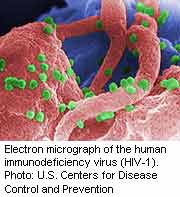
TUESDAY, Nov. 20 (HealthDay News) — International health officials on Tuesday reported continued headway against HIV/AIDS — not only with a drop in the number of new HIV infections, but also a dramatic rise in the number of people in treatment.
That translates to 500,000 fewer people dying worldwide from AIDS in 2011 than died from the disease in 2005, the experts said.
Many of these gains are to be seen in sub-Saharan Africa, one of the hardest-hit regions of the world, according to the report from the Joint United Nations Programme on HIV/AIDS (UNAIDS).
For instance, rates of new HIV infections have declined by 73 percent in Malawi, 71 percent in Botswana, 68 percent in Namibia, 58 percent in Zambia, 50 percent in Zimbabwe and 41 percent each in South Africa and Swaziland since 2001.
“These are very, very impressive figures in countries like Malawi, which are on the lower end of the income scale and are managing a very large number of HIV infections in their countries,” Dr. Bernhard Schwartlander, director for evidence, strategy and results at UNAIDS, said at a Tuesday news conference.
Meanwhile, the number of people receiving powerful antiretroviral therapy to suppress HIV has increased by about 60 percent in just the last two years, the report found. South Africa, for one, has increased treatment by 75 percent in the last two years, adding 1.7 million people to the roles of people receiving appropriate care. In China, the rate of people being treated has risen by 50 percent in the last year.
The decline in new infections, combined with more treatment opportunities, is accompanied by a drop of one-third in AIDS-related deaths in the last six years. Again, the most progress is being seen in parts of Africa that have been ravaged by the disease.
Perhaps the most heartening news, though, was a dramatic 24 percent decline in new HIV infections among children. In some countries in Africa, that number rose to 40 percent.
“[Regarding] the quickening in the pace of progress, we have achieved in the past two years what took us before a whole decade,” said Schwartlander. He attributed the progress to more domestic and international resources being committed to fighting HIV/AIDS.
The second factor is dramatically simplified treatment approaches, with many people on a once-a-day pill regimen that is relatively low-cost, he said.
Still, there needs to be more focus on the most at-risk populations, Schwartlander said. These include injecting drug-users, gay and bisexual men, and sex workers. In the United States, for instance, there has been a spike in the number of new infections among gay African American and Hispanic men, a highly vulnerable population, Schwartlander noted.
And the report notes that the fight is far from over: Today, there remain 34 million people living with HIV/AIDS around the globe, as well as 2.5 million new infections and 1.7 million deaths annually.
More information
Find out more about HIV/AIDS at the U.S. Centers for Disease Control and Prevention.

